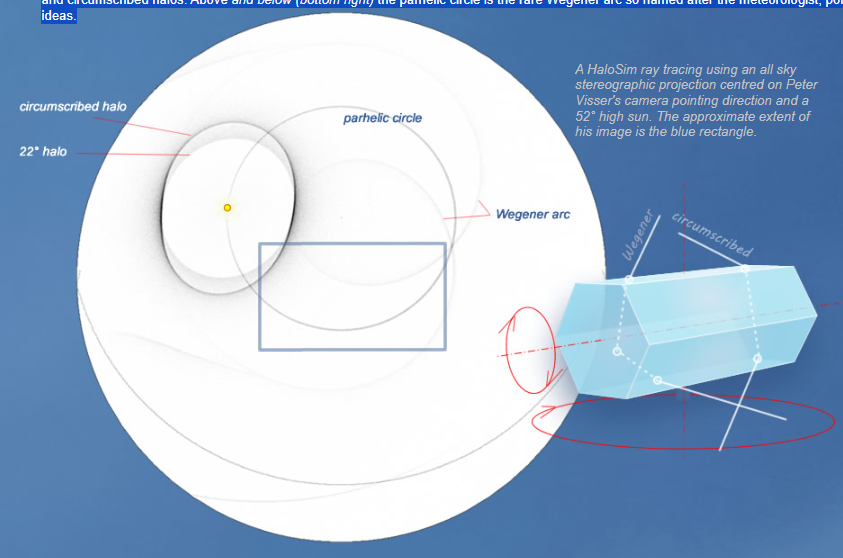Wegener arc and parhelic circle, The Netherlands - OPOD
Exploring the Wegener Arc and Parhelic Circle in the Netherlands
Atmospheric optics never fails to surprise us with its mesmerizing displays. One such enchanting phenomenon is the Wegener arc and parhelic circle, captured beautifully in the Netherlands by Peter Visser on July 16th, 2015. In this article, we will delve deeper into these rare optical phenomena and uncover the science behind their formation.
The Parhelic Circle
A prominent feature in Visser's image is the parhelic circle, a white arc that gracefully curves across the frame. This circular band of light is formed by sunlight interacting with ice crystals in the atmosphere. It appears at the same altitude as the Sun, but on the opposite side of the sky. The parhelic circle is often seen in conjunction with other atmospheric halos, such as the 22° halo and circumscribed halos, which are visible at the top left of the image.
The Wegener Arc
Adjacent to the parhelic circle, we find the rare Wegener arc. Named after Alfred Wegener, a renowned meteorologist and pioneer of continental drift theories, this arc completes a full circle around the sky, extending from the top of the circumscribed halo to its base. The Wegener arc intersects with the parhelic circle at a point known as the anthelic point.
Understanding the Wegener Arc Formation
To comprehend the formation of the Wegener arc, we must examine the properties of ice crystals in the atmosphere. Horizontal columns and randomly oriented crystals are sufficient to recreate this atmospheric phenomenon. While plate crystals could potentially be present, column crystals are primarily responsible for generating the Wegener arc.
The Wegener arc differs from other halos, such as the circumscribed halo, due to its unique interaction with column crystals. These crystals have side faces inclined at an angle of 60°. The Wegener rays enter and leave these column crystals through their side faces, but what sets them apart is that they are internally reflected from an end face.
The Rarity of the Wegener Arc
The rarity of the Wegener arc can be attributed to the optical imperfections of the end faces of column crystals. These end faces are often indented and optically imperfect, making it less likely for the internal reflection to occur consistently. Therefore, whenever a strong parhelic circle is observed, it is worth looking for the presence of the elusive Wegener arc.
Conclusion
The Wegener arc and parhelic circle, captured in the Netherlands by Peter Visser, provide us with a captivating glimpse into the world of atmospheric optics. These optical phenomena arise from the interaction of sunlight with ice crystals in the atmosphere. The parhelic circle, a circular band of light opposite the Sun, is often accompanied by other halos. The Wegener arc, named after Alfred Wegener, completes a full circle around the sky and intersects with the parhelic circle at the anthelic point. Its rarity stems from the optical imperfections of the end faces of column crystals. Next time you witness a parhelic circle, keep an eye out for the elusive Wegener arc, and let yourself be enchanted by the wonders of our atmosphere.

Parhelic Circle & Wegener Arc, The Netherlands ~ Imaged 16th July '15 by Peter Visser. A white parhelic circle curves across the frame. At top left are the 22° halo and circumscribed halos. Above and below (bottom right) the parhelic circle is the rare Wegener arc so named after the meteorologist, polar researcher and originator of continental drift ideas.

A HaloSim ray tracing using an all sky stereographic projection centred on Peter Visser's camera pointing direction and a 52° high sun. The approximate extent of his image is the blue rectangle.
Horizontal columns and some randomly oriented crystals are sufficient to reproduce the display (although plate crystals might have been present).
The complete Wegener arc circles the sky from the top of the circumscribed halo to its base. It crosses the parhelic circle at the anthelic point.
Wegener rays enter and leave column crystals through side faces inclined at 60° but differ from those generating the circumscribed halo in that they are internally reflected from an end face.
The end face reflection accounts for their rarity because end faces are often indented and optically imperfect.
Whenever there is a strong parhelic circle that might also be from the end faces of column crystals, look for the Wegener arc.
Note: this article has been automatically converted from the old site and may not appear as intended. You can find the original article here.
Reference Atmospheric Optics
If you use any of the definitions, information, or data presented on Atmospheric Optics, please copy the link or reference below to properly credit us as the reference source. Thank you!
-
<a href="https://atoptics.co.uk/blog/wegener-arc-and-parhelic-circle-the-netherlands-opod/">Wegener arc and parhelic circle, The Netherlands - OPOD</a>
-
"Wegener arc and parhelic circle, The Netherlands - OPOD". Atmospheric Optics. Accessed on November 24, 2024. https://atoptics.co.uk/blog/wegener-arc-and-parhelic-circle-the-netherlands-opod/.
-
"Wegener arc and parhelic circle, The Netherlands - OPOD". Atmospheric Optics, https://atoptics.co.uk/blog/wegener-arc-and-parhelic-circle-the-netherlands-opod/. Accessed 24 November, 2024
-
Wegener arc and parhelic circle, The Netherlands - OPOD. Atmospheric Optics. Retrieved from https://atoptics.co.uk/blog/wegener-arc-and-parhelic-circle-the-netherlands-opod/.